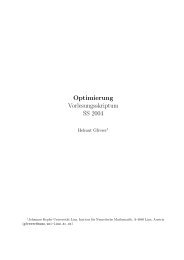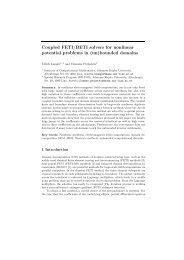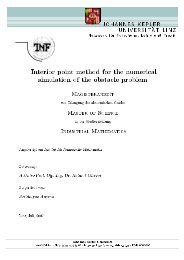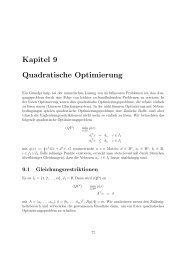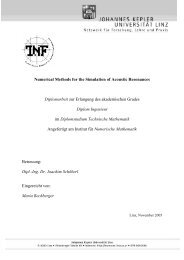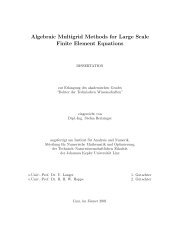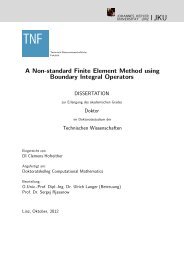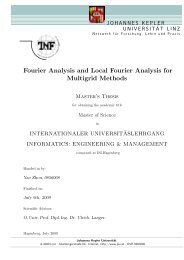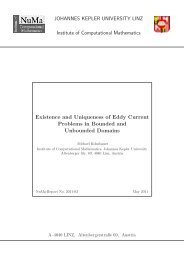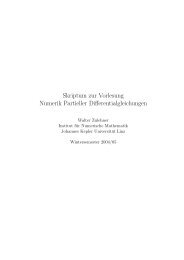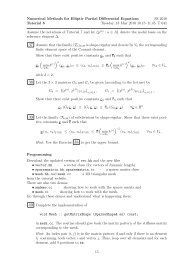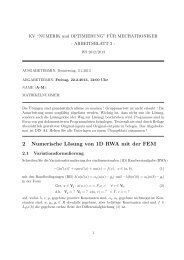PDF file - Johannes Kepler University, Linz - JKU
PDF file - Johannes Kepler University, Linz - JKU
PDF file - Johannes Kepler University, Linz - JKU
You also want an ePaper? Increase the reach of your titles
YUMPU automatically turns print PDFs into web optimized ePapers that Google loves.
CHAPTER 1. INTRODUCTION 10<br />
memory and CPU speed of today’s generation of computer hardware. A solution to this<br />
problem are the algebraic multigrid (AMG) methods, where the initial mesh is used as<br />
finest level, and the coarser levels are generated using (almost) only information of the<br />
algebraic system.<br />
A second reason for the popularity of AMG methods is their “black-box” character. In<br />
an ideal situation the user does not need to construct any hierarchy, the method operates<br />
on one single algebraic system and can therefore be used e.g. as a replacement for the direct<br />
solver on the coarsest level of a geometric multigrid algorithm.<br />
Since the pioneering work of Ruge and Stüben [RS86] and Brandt et al. [BMR84]<br />
these methods have been applied to a wide class of linear systems arising (mostly) from<br />
scalar partial differential equations. For an overview of the technique itself and various<br />
applications we refer for example to Stüben [Stü01b].<br />
For the application of AMG to saddle point problems one has the same two general<br />
possibilities as in the geometric multigrid case. The first is the segregated approach, i.e. to<br />
use a classical method (Uzawa, SIMPLE,. . . ) for an outer iteration and to apply AMG to<br />
the resulting elliptic problems. This approach is described e.g. by Griebel et al. [GNR98]<br />
or Stüben [Stü01a]. Another idea in this class is to use a Krylov space method such as<br />
GMRES or BiCGstab with a special preconditioner which again decouples velocity and<br />
pressure equations. This was done for example by Silvester et al. first for the Stokes case<br />
[SW94] and later for the Navier-Stokes problem [SEKW01].<br />
The focus of our work lies on the second possibility, on the coupled approach where<br />
an AMG method for the whole saddle point system is developed (as mentioned above for<br />
GMG methods). Work in this direction has been done for example by Webster [Web94] and<br />
Raw [Raw95] for finite volume discretizations of the Navier-Stokes equations, by Bertling<br />
[Ber02] for a finite element discretization of the Stokes equations, by Adams for contact<br />
problems in solid mechanics [Ada03], and by Bungartz for constrained optimization (with<br />
a small number of constraints) [Bun88].<br />
This thesis is structured as follows. The second chapter contains the preliminaries which<br />
are needed for a numerical solution of the Navier-Stokes equations. We start with the problem<br />
statement, continue with the weak formulation and the finite element discretization,<br />
sketch the analysis of the associated Stokes problem, mention some problems induced by<br />
the convection, and finally discuss classical solution methods for the linear system.<br />
In the third chapter we introduce algebraic multigrid methods. In this chapter we will<br />
apply it only to scalar equations, but the underlying ideas will be important for the saddle<br />
point case, too.<br />
The central part of this work is chapter four, where we develop methods for the coupled<br />
application of AMG methods to saddle point systems. We provide ideas for the construction<br />
of multigrid hierarchies for different types of mixed finite elements, and we will deal with<br />
stability problems which may occur on coarse levels. Unfortunately (but not surprisingly)<br />
we were not able to construct a “black box method” capable of any saddle point problem,<br />
with whatever choice of discretization on an arbitrary mesh. All our methods depend for<br />
example on the concrete choice of the finite element.<br />
Finally, chapter five is devoted to the presentation of numerical results. After a short



